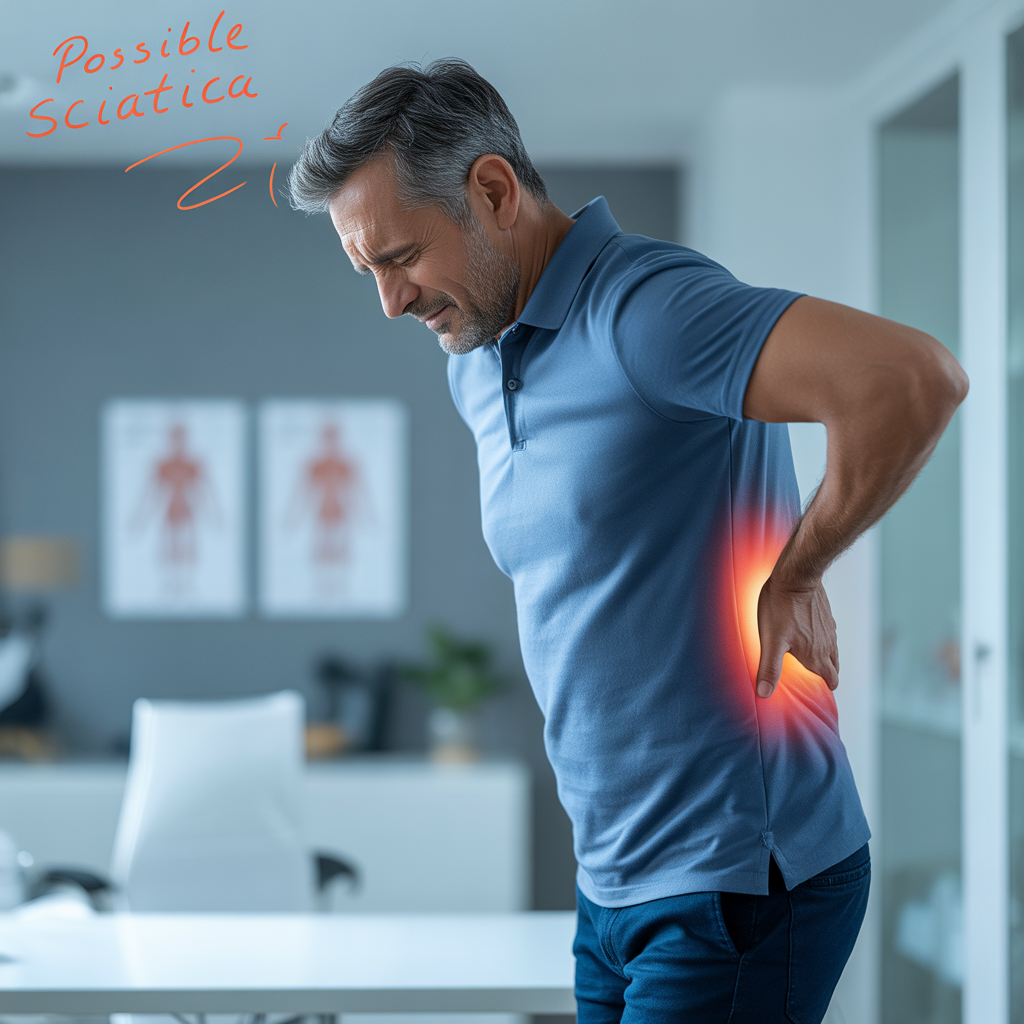Clermont sciatica acting up? Learn what really works—from positions of relief to the right exercises, driving/desk tweaks, and when to seek care.
If pain is shooting from your low back or hip into your butt, thigh, or calf, you don’t need another generic list of stretches—you need a plan that calms the nerve and gets you moving again. This guide covers exactly that, with Clermont-specific tips for desk work, US-27/SR-50 commuting, and weekend activities around the hills and lakes.
What “sciatica” really means (fast version)
“Sciatica” describes irritation of the sciatic nerve—most commonly from a lumbar disc bulge, irritated facet joint, or a tight/deconditioned hip (often the piriformis). Your plan should reduce nerve irritation today, then restore strength and movement so it doesn’t keep coming back.
What works first: calm the nerve, find your “direction of relief”
Your body will usually prefer either gentle extension (arching) or gentle flexion (rounding) for short bouts. The right direction is the one that pulls pain out of the leg and back toward the spine (called centralization). If pain spreads further down the leg, back off that movement.
Positions of relief (test for 30–60 seconds):
- Extension-biased: Lie prone (on your belly) with a small pillow under your hips, or prop on elbows.
- Flexion-biased: Lie on your back with legs on a chair (90–90), or on your side with a pillow between knees.
- Neutral unload: Short walks on flat ground at an easy pace.
Keep whichever position reduces leg symptoms handy—you’ll use it between activities.
The 14-Day Clermont Sciatica Plan
Phase 1 (Days 1–4): Settle it down
- Come see us at NuWave!: First and foremost, the sooner you can come in for exam/treatment the better!
- Move often, a little: 5-minute easy walks, 4–6×/day.
- Unload after sits/drives: 60 seconds in your best relief position.
- Desk setup: Hips slightly higher than knees, lumbar roll at belt line. Stand 1–2 minutes every 30–45 minutes.
- Driving: Slight seat recline (100–110°), knees just below hips, small towel at low back; pause every 45–60 minutes.
- Avoid (for now): Deep hamstring stretches, aggressive twisting, prolonged slumped sitting.
Phase 2 (Days 5–10): Restore motion that centralizes symptoms
- Pick one primary drill (2–3 sets, 8–10 reps, 2–3×/day):
- Prone Press-Ups (extension-biased): From prone on elbows, press up through hands, hips stay down. Pause 1–2s.
- Knees-to-Chest (one at a time) (flexion-biased): Gently draw one knee up, pause 3–4s, switch.
- Add gentle nerve mobility (if leg pain is easing): Sciatic sliders
- Sit tall. Extend knee while toes point up and look down; then bend knee and look up. Slow, pain-free range, 10 reps.
- Walking goal: Build to 10–15 minutes daily.
Phase 3 (Days 11–14): Build resilience
- Core staples (every other day):
- Side Plank (knees or feet) × 2 sets/side, 10–20s holds
- Bird Dog × 6–8 reps/side, slow & controlled
- Hip strength: Glute Bridge × 10–12, pause 2s at top.
- Lifestyle: Two brisk lake-loop walks this week, hydration on point, avoid “weekend warrior” lifts.
If any drill increases leg symptoms, reduce the range or switch to your relief position and try again later.
Clermont-specific tweaks that help a ton
- Desk days (teachers, office, remote): Lumbar roll, screen at eye height, feet supported, 20-20-20 eyes, stand every 30–45 minutes.
- Commuters (US-27/SR-50): Keep wallet/phone out of back pocket; micro-shrug/shoulder rolls at red lights; exit the car by pivoting both legs out first, then stand.
- Hills & trails: Choose flat routes at first. Progress hills when leg pain has centralized for 7–10 days.
- Sleep: Side lying with a firm pillow between knees; back sleeping with pillow under knees.
What to stop doing (for now)
- Long static stretching of hamstrings/piriformis when the nerve is hot (often makes symptoms worse).
- “Push through it” lifting (deadlifts, heavy yardwork) during a flare.
- All-day sitting, even in a great chair—set timers to move.
When to get imaging or a referral
You usually don’t need an MRI right away, or wait to start treatment until you have a MRI done. Consider imaging or referral if:
- Red-flag signs (below)
- Severe or progressive weakness (foot drop, can’t toe/heel walk)
- Bowel/bladder changes or numbness in the saddle area
- Pain not improving after 6–8 weeks of good conservative care
Red flags: Go to urgent care/ER
- Sudden, severe “tearful” back pain with bowel/bladder loss or saddle anesthesia
- Fever, unexplained weight loss, history of cancer, IV drug use, major trauma
- Rapidly worsening leg weakness or numbness
FAQ we hear in clinic
How long does sciatica take to get better?
Many acute cases improve within 2–6 weeks; stubborn cases can take longer. Consistency wins.
Do I need to stop working out?
You may need to modify, not quit. Keep walking and core work. Re-introduce lifting with guidance when leg pain has centralized.
Is surgery inevitable?
No. Most cases resolve with a precise conservative plan. Surgery is reserved for specific situations (severe/progressive deficits or failed conservative care).
Do standing desks fix sciatica?
They help you vary positions. The best posture is your next one—keep moving.
Ready for a plan tailored to your pattern?
Bring a few photos of your desk and car setup and note which positions reduce or increase your leg pain. We’ll test your spine, hips, and nerve mobility, then map a simple plan that centralizes symptoms fast.
New here? When scheduling mention our $49 Spine Check—quick consult, movement screen, and personalized relief plan.
Visit our contact page to schedule!
Educational only and not a diagnosis. If you have red-flag symptoms, seek urgent care.

